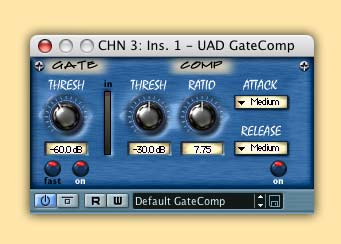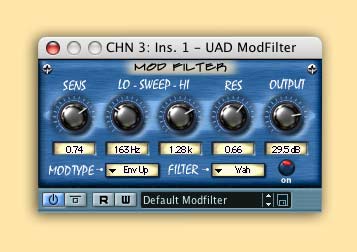|
|
Q: Are the modules within Nigel tuned specifically for guitar, or are they just generic effects packaged as a guitar product? What went into the design of these modules?
A: Most of Nigel’s modules were created and voiced with guitar in mind, but in many cases these effects can be used effectively with other instruments. For next two issues, we’ll take a look at several of the modules within Nigel and talk about what went into their design. We will start off this month with the Gate, Compressor, and Mod Filter modules.
 Nigel Gate
Nigel GateNoise gating is a good example of an effect whose design depends heavily on the intended application. In situations where there is a relatively low noise floor but where there may be many ‘silent’ segments of a track, it might be desirable to have a gate which completely suppresses the signal when it is consistently below a particular threshold. If the noise floor is low enough, this can be accomplished without severe artifacts. However, if the noise floor is high, or if the signal level is often comparable to the noise floor, it is critical that the gating be implemented in such a way that artifacts associated with the gating are minimized. This usually favors use of a ‘downwards expander’, which suppresses noise in a graduated way as the level dips below the threshold. For guitar applications, because of the huge amounts of gain involved, there is typically a high noise floor, with the signal often dipping to levels at or below the noise. For this reason, the gate within Nigel is implemented as a downwards expander. Also because of the high noise levels typically involved, the expansion ratio is progressive, meaning that as the signal dips below the threshold of the gate, the expansion ratio moves smoothly and progressively away from 1:1. The disadvantage of this type of noise gate is that it fails to completely eliminate background noise, but instead only suppresses it. However, when noise floors are high, a downwards expander can be used more easily to get a compromise between musicality and noise suppression. With Nigel’s progressive ratio, the threshold can be used with relative ease to dial in the amount of suppression desired at the noise floor.
This gate can be used with some success on other signals. However, it was specifically designed for guitar, where the noise floor can be very high
Nigel’s Gate Comp Plug-In
Nigel Compressor
The compressor within Nigel was also specifically designed for guitar, and uses a different algorithm than the compressor in the EX-1 or any of the vintage compressors that run on the UAD. In terms of description, it is probably most similar to a “feed forward” version of an 1176, without the program dependence. Since guitar is, for the most part, a tonal instrument, most compression applications for guitar are not geared towards transient control, but rather for 1) smoothing of phrasing, 2) control over tone envelopes, or 3) timbral changes. The compressor within Nigel was designed to work nicely for these applications, and the release mechanism was chosen accordingly. The release curves followed by this compressor are similar to those found in some of the more popular guitar stomp-box compressors, such as the MXR Dynacomp and Analog Man Bi-Comprosser.
The attack and release time-constants for this compressor were chosen with guitar in mind as well. For release, the ‘slow’ setting is appropriate for smoothing out phrasing, the ‘medium’ setting will help out with sustain, and the ‘fast’ setting will probably add a bit of bite to the timbre of a guitar, especially in the low range. For attack, the ‘slow’ setting will probably be mostly transparent for picked/plucked sounds. The ‘medium’ setting will add a synthetic thump, and the ‘fast’ setting is fast enough to create a more rounded attack sound.
Although these settings were created with guitar in mind, this compressor may be useful on any track where other compressors are not giving the desired result. It certainly will sound different than any of the other compressors on the UAD, and should, in most cases, perform smooth and pleasant compression. Give it a try the next time you can’t find the ‘right’ compressor! [I like it on kick. –ed.]
 Mod Filter
Mod FilterThe mod filter within Nigel was modeled after a few popular products including the Mutron III and the ubiquitous Jim Dunlop Crybaby, using schematics and measurements of well-maintained units. The intent of the design was to provide a module that could get the sounds of vintage units, but was flexible and easy to control. The filters were designed using the same modeling techniques that we used to model all of our vintage-type plug-ins, and they match the units we modeled to the same degree of accuracy. But, in the interest of flexibility, we released this module as a ‘modern’ device rather than a ‘model’, with many functions/sounds built into one unit.
Next month: Nigel Pre-Flex, Cabinet, and Phasor modules.
-Dave Berners